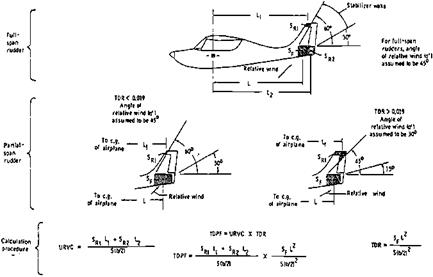Design for Spin Recovery
Simple preliminary design rules that would increase the chances for an airplane to have satisfactory recovery characteristics from spins were an important product of the NACA spin tunnel group. Figure 9.4 reproduces the best-known set of preliminary design rules (Neihouse, Lichtenstein, and Pepoon, 1946). Two separate parameters are used. One
|
Figure 9.3 An example of the standardized spin recovery charts produced by the NASA Langley spin tunnel. The box locations correspond to control positions for the developed spin that precedes the recovery attempt. Blanks generally correspond to control positions for which the model would not spin. This particular chart is for the Grumman OV-1 Mohawk Army observation airplane. (From Lee, NASA TN D-1516, 1963) |
is called TDR, the tail damping ratio, affecting whether the steady spin is steep or flat. The other is called URVC, the unshielded rudder volume coefficient, based on the rudder areas nominally out of the horizontal tail wake and their moment arms. The product of the two parameters is the tail damping power factor, or TDPF.
The 1946 TDPF design rules are a modification of a Royal Aircraft Establishment (RAE) criterion by E. Finn. Both the RAE and NACA criteria are based on empirical results, grounded in the flight mechanics of spins. For example, the TDR rule specifies a minimum
|
Figure 9.4 Method of applying the 1945 Neihouse/Lichtenstein/Pepoon tail design requirements for satisfactory spin recovery, a controversial standard because it neglects factors otherthan the tail. (From Stough, Patten, and Sliwa, NASA TP 2644, 1987) |
fuselage area under the horizontal tail for the spin to be normal, and not the flat, high-rotation – rate variety. At spin attitudes, that is, at high angles of attack and large yawing velocities, that particular area should indeed develop high static pressures and a considerable yawing moment resisting the spin rate, or damping the spin.
The 1946 NACA TDPF design rules were followed one year later by design rules drawn up specifically for personal-owner-type airplanes (Figure 9.5). The 1947 NACA TDPF rules use a 60-airplane subset of the 100 airplanes on which the 1946 rules are based. Both sets of tail design rules are considered to be a useful guide for airplanes with the general layout and weight distribution of that period in aeronautics. This includes propeller-driven general – aviation airplanes of the present day, so it is a source of wonder and alarm that these rules are ignored by many modern designers.
On the other hand, James S. Bowman, Jr., recently retired from NASA, points to cases in which light airplane configurations that satisfy the 1947 TDPF criterion have unsatisfactory spin recovery characteristics, weakening the case for applying the criterion to present-day airplanes. This is further discussed in Section 9.11, “The Break With the Past.”















